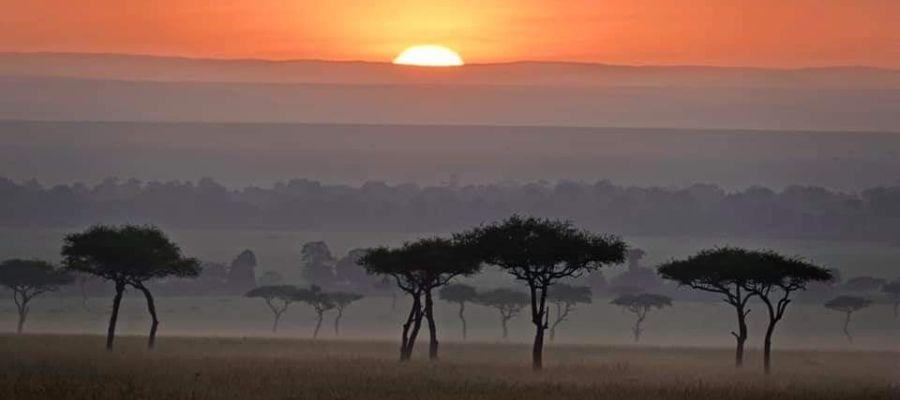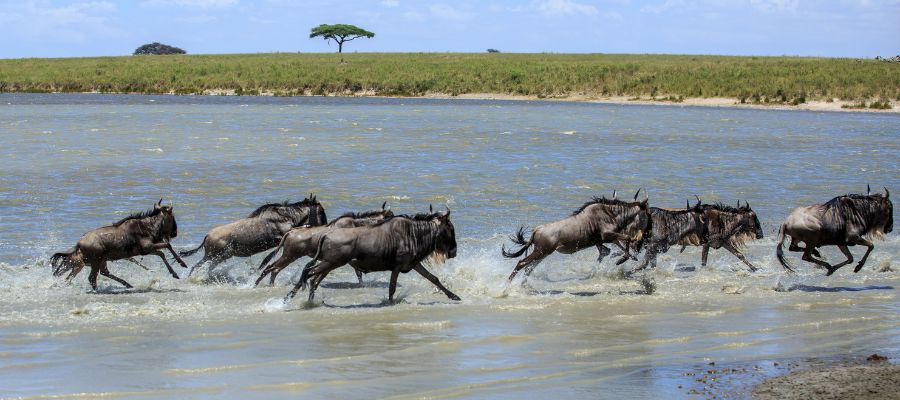The Great Migration is the stunning movement of over a million wildebeests from Tanzania's Serengeti to Kenya's Masai Mara Reserve. This annual event showcases incredible wildlife behavior and follows rainfall patterns.

To witness the migration, plan your trip for mid-July to September, when the herds arrive. The journey includes perilous river crossings teeming with crocodiles. Here are common migration-related questions for travelers.
When Does the Wildebeest Migration Occur?
The Wildebeest Migration is a massive annual movement of wildebeest, zebra, and other animals across the Serengeti National Park in Tanzania and the Maasai Mara National Reserve in Kenya. The migration takes place in a clockwise direction, and the animals follow the rains in search of fresh grazing.
The migration typically starts in May or June in the Serengeti and ends in November or December in the Maasai Mara. However, the exact timing of the migration can vary from year to year, depending on the weather conditions.
Here is a more detailed breakdown of the timing of the migration:
- May or June: The wildebeest start to move north from the Serengeti in search of fresh grazing.
- July: The wildebeest reach the Maasai Mara.
- August: The wildebeest give birth to their calves.
- September: The wildebeest start to move south again.
- October or November: The wildebeest reach the Serengeti.
- December: The wildebeest start the cycle all over again.
The River Crossings

One of the most dramatic parts of the Wildebeest Migration is the river crossings. The wildebeest have to cross several rivers during their journey, including the Mara River. These river crossings are dangerous for the wildebeest, as they are often hunted by crocodiles. However, the wildebeest are incredibly strong swimmers, and they are able to make the crossing safely.
The river crossings are a great opportunity to see the Wildebeest Migration up close. If you are planning to visit the Serengeti or the Maasai Mara, be sure to time your trip to coincide with the river crossings.
Tips for Viewing the Wildebeest Migration
If you are planning to visit the Serengeti or the Maasai Mara to see the Wildebeest Migration, there are a few things you should keep in mind:
- The best time to see the migration is during the dry season, which is from June to October.
- The migration is a large and unpredictable event, so it is important to be flexible with your plans.
- There are many different tour operators that offer trips to see the migration. Be sure to do your research and choose a reputable operator.
- The migration is a once-in-a-lifetime experience, so be sure to pack your camera and your binoculars!
The Best Time to Visit Masai Mara for the Migration
The best time to visit Masai Mara to see the Migration is during the dry season, which typically runs from June to October. During this time, the wildebeest herds migrate from the Serengeti National Park in Tanzania to the Masai Mara National Reserve in Kenya. The herds typically cross the Mara River in July and August, and this is the best time to see them.
The best time to visit Masai Mara to see the Migration:
- June: The herds begin to migrate from the Serengeti to the Masai Mara.
- July: The herds cross the Mara River and the Migration is in full swing.
- August: The Migration peaks and is the best time to see the herds.
- September: The herds begin to move back to the Serengeti.
- October: The herds have mostly returned to the Serengeti and the Migration is over.
It is important to note that the Migration is a natural event and the exact timing can vary from year to year. However, the months of July and August are typically the best time to see the herds.
Tips for planning your trip to see the Migration:
- Book your trip in advance, as the Masai Mara is a popular destination during the Migration season.
- Choose a reputable tour operator who can help you plan your trip and get you to the best viewing spots.
- Be prepared for hot weather and dust.
- Bring binoculars and a camera to capture the amazing sights.
The Great Migration is an incredible natural event that is sure to be a highlight of your trip to Africa. By planning your trip carefully, you can increase your chances of seeing this amazing spectacle.
Where Do the Wildebeest Migrate To and From?
The wildebeest migrate between the Serengeti National Park in Tanzania and the Maasai Mara National Reserve in Kenya.
Why do the wildebeest migrate?
The wildebeest migrate in search of food and water. The Serengeti is a vast area, but the grass does not grow evenly. The wildebeest follow the rains, which bring new growth to the grass. They also migrate to avoid predators.
When do the wildebeest migrate?
The wildebeest migration takes place over the course of a year. The wildebeest begin their migration in May or June, when the rains start in the Serengeti. They move north, crossing the Grumeti River and the Mara River. They reach the Maasai Mara in July or August. In October or November, the wildebeest begin their journey back to the Serengeti.
What are the dangers of the wildebeest migration?
The wildebeest migration is a dangerous journey. The wildebeest must cross rivers that are home to crocodiles. They are also hunted by predators such as lions, hyenas, and cheetahs.
Why is the wildebeest migration important?
The wildebeest migration is an important part of the African ecosystem. The wildebeest help to fertilize the land with their manure. They also provide food for predators and other animals. The wildebeest migration is a natural wonder that is a must-see for any safari enthusiast.
Here is a list of the main points:
- The wildebeest migrate between the Serengeti National Park in Tanzania and the Maasai Mara National Reserve in Kenya.
- The wildebeest migrate in search of food and water.
- The wildebeest migration takes place over the course of a year.
- The wildebeest migration is a dangerous journey.
- The wildebeest migration is an important part of the African ecosystem.
Witnessing the Phenomenon: How to Experience the Wildebeest Migration
The Wildebeest Migration is a spectacular natural phenomenon that takes place in the Masai Mara Game Reserve in Kenya. Millions of wildebeest, accompanied by zebras and gazelles, migrate from the Serengeti National Park in Tanzania to the Masai Mara Game Reserve in search of food and water.
How to Experience the Wildebeest Migration?
To witness this magnificent event, you can take a safari game drive in the Masai Mara Game Reserve. The game drive is conducted in specialized vehicles driven by experienced driver-guides who are knowledgeable about the migration and can provide valuable insights.
Accessing the Vantage Points:
As there are several core points where the wildebeest cross the rivers, it may be necessary to access and station oneself at these points during a day-long outing in the reserve. Some of the lodges and camps can be up to an hour's drive from the ideal vantage points, so planning ahead is essential.
Staying at Crossing Points:
Most tourists who come specifically to see the migration consider seeing the river crossings a highlight of their tour and therefore want to spend enough time at these crossing points. These points tend to vary slightly every year while staying within a generally similar sub locality of the reserve.
Conclusion:
Experiencing the Wildebeest Migration is a once-in-a-lifetime opportunity that is not to be missed. By taking a safari game drive in the Masai Mara Game Reserve and stationing oneself at the core crossing points, one can witness this awe-inspiring natural event and create unforgettable memories.
Month-by-Month Guide to the Wildebeest Migration
The Great Migration is not a one-time event but happens all year round. The river crossing, which is the most popular event, occurs around late July to August and again in October to November. It's difficult to predict the herds' movement as it's prompted by rain. The best times to track and see the annual wildebeest migration in Masai Mara are during these periods.
December To April
Best time to see the herds of wildebeest in the southern Serengeti National Park is between December and April, depending on the rains. February is the calving season and offers the best chance to witness a wildebeest birth. Predators like lions and leopards are also active during this time. The herds start their northward journey in March/April, with many already moving towards the central and western Serengeti.
May To June
During May to June, the migratory herds move north in search of fresh grazing and water. The migration can be seen as huge columns up to 40 kilometers long, containing hundreds of thousands of wildebeest, zebras, and gazelles. June marks the end of the rainy season and traditionally the Grumeti River crossing period, where Nile Crocodiles can be spotted, although it's not as spectacular as the Mara River crossings.
July To September
From July to September, the wildebeest migration occurs in the Serengeti and Masai Mara. The herds cross the Mara River, with half remaining in the northern Serengeti and the rest moving into the Masai Mara Reserve. This is the most exciting time to witness the migration.
October To November
From October to November, the wildebeest herds migrate south through western Loliondo and the Serengeti National Park's Lobo area, to find fresh grazing in the north-eastern and southern Serengeti where water is abundant. Calving begins again and predators move in.